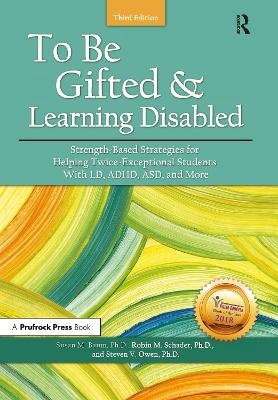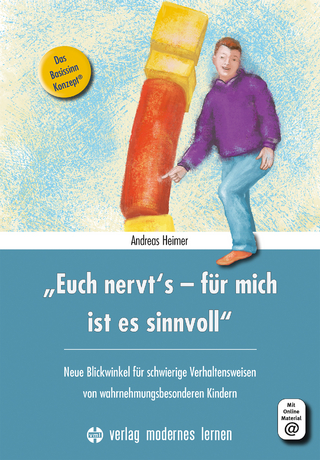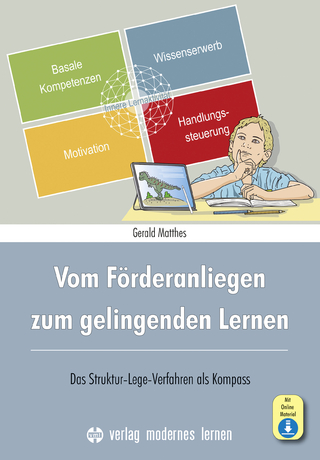
To Be Gifted and Learning Disabled
Prufrock Press (Verlag)
978-1-61821-644-1 (ISBN)
2018 NAGC Book of the Year Award Winner
Susan M. Baum, Ph.D., is the Director of the 2e Center for Research and Professional Development at Bridges Academy, a school for twice-exceptional students. Robin M. Schader holds a Ph.D. in Educational Psychology from the University of Connecticut, specializing in Gifted and Talented Education with a focus on talent development and the role of parents. She worked as a research professor at the University of Connecticut and, for 10 years, and was the Parent Resource Advisor for the National Association for Gifted Children (NAGC).
Acknowledgements Introduction Notes on This Edition How This Book Is Organized Part I: The 2e Basics Chapter 1 Twice-Exceptionality Evolving Definitions and Perceptions The Story of Neil Twice-Exceptional: The Term and Its History Origins of Twice-Exceptionality in Education Legislation Paves the Way In the 21st Century A New Definition: A New Basis for Action The Story of Neil, Continued Seeing 2e Through a New Lens Chapter 2 The Yellows and the Blues of Twice-Exceptionality The First “e”: Gifted and Giftedness, or What We Call “Yellow” Historical Perspectives on Giftedness Characteristics of Giftedness The Second “e”: Differences, Disabilities, or What We Call “Blue” Specific Learning Disabilities Attention Deficit/Hyperactivity Disorder Autism Spectrum Disorders Generalized Anxiety Disorder Chapter 3 Complexities of Green Twice-Exceptional Students: Three Groups 2e Students Identified by Gifts With Undiagnosed Disabilities 2e Students Identified Only for Special Programming or Accommodations Students Not Identified With Either High Abilities or Special Needs Dynamics of a High Abilities/Learning Disabilities Mix Increased Intensity Trait Inhibition Emergence of Additional Traits The Paradoxical Needs of a 2e Learner A Very Green Tale: The Story of Olivia Chapter 4 The Case for Strength-Based, Talent-Focused Education What 2e Students Need Research Pointing to the Benefits of Starting With Strengths New Evidence for Using a Strength-Based Approach Growth Factors Contributing to Growth Part II: Neurodiversity The Complex Minds of 2e Learners Chapter 5 2e Students and Learning An Information Processing Model: Explaining Learning Attention, Sensory Input, and Sensory Storage Working Memory/Short-Term Memory Passing From Working Memory to Long-Term Memory (Encoding and Retrieval) Long-Term Memory Acting on Information: Production/Expression Executive Function and Self-Regulation Skills When Learning Becomes Difficult Problems With Attention and Sensory Input and Storage Working Memory/Short-Term Memory Difficulties Problems Passing Information From Working Memory to Long-Term Memory Long-Term Memory Problems Problems With Production Executive Functioning Problems Issues With Anxiety Chapter 6 Multiple Intelligences and Personality Preferences Multiple Intelligences Applying Information About Multiple Intelligences Personality Preferences Personality Preferences and the Twice-Exceptional Learner Four Personality Patterns Applying Information About Personality Preferences Chapter 7 Factors Leading to Misidentification and the Perils of Misinterpretation What Is the Problem? Blaine’s Story Looking at the Issues Contemplating Problems From Diverse Perspectives Emotional Development of Gifted Students Creative or Disruptive? That Is the Question IQ Testing and the Use of Subtest Indices and Scores Attention Issues and High-Ability Students: Cause or Effect? Excessive Engagement: Passions or Obsessions? Understanding Social Context and Emotional Issues Part III: Comprehensive Programming Chapter 8 Identifying 2e Students in Educational Settings Searching for Blue: Challenges and Practices for the Identification of Learning Disabilities and Other Special Education Needs in Gifted Students RtI and Identifying the Disabilities of Twice-Exceptional Students Why RtI Might Not Be the Best Solution Collecting Evidence: Understanding the Problem Searching for Yellow: Challenges and Practices for the Identification of Gifts and Talents in Special Education Populations A Priori Identification Dynamic Identification: Using Authentic Activities to Tap Potential Chapter 9 Elements of Strength-Based Plans for 2e Students Programming for Green Critical Factors Grounding Successful Program Development Does It Provide a Psychologically Safe Environment? Does It Respect the Need for More Time? Does It Take Into Account the Asynchronous Development of 2e Students? Does It Foster Opportunities to Forge Positive Relationships? Does It Incorporate a Strength-Based, Talent-Focused Philosophy? Necessary Components for Comprehensive Plans The Talent Centered Model for Twice-Exceptional Students The Model in Action Least Restrictive Environment, Individual Educational Plans, and 504 Plans Chapter 10 Talent Recognition and Development A Rationale for Talent Development Bryan Lessons Learned From Bryan’s Story Finding Talent Development Opportunities Placement in Existing Programs Special Opportunities Mentorships Special Programs and Schools Part IV: Strategies That Work Chapter 11 Creating a Strength-Based, Dually Differentiated Classroom What Is Dual Differentiation? What Is a Strength-Based Approach? Leveraging Strengths to Support Skill Development Using Strengths to Encourage Active Participation in Learning and Productivity Revisiting Olivia, Blaine, and Melanie Chapter 12 Classroom Strategies for Success Intellectual, Physical, and Emotional Environments The Intellectual Environment Using Appropriate Entry Points Performance-Based Assessments With Differentiated Exit Points Investigating Authentic Problems Engaging Students in Critical and Creative Thinking Modifications to the Physical Learning Environment Strategies to Help With Hypersensitivity and Other Distractions Accommodating the Need for Movement Seating and Grouping Arrangements Providing Resources Creating a Supportive Emotional Environment Create Learning Communities Teach Executive Function Skills: Time Management and Organization Teach Stress Management, Conflict Resolution, and Anger Management Skills Use Authentic Contexts for the Development of Social Awareness, Social Skills, and Building Friendships Chapter 13 When Learning Breaks Down Modifications and Accommodations Focusing and Sustaining Attention Accessing Information With Limited Reading Skills Accommodations to Address Deficits in Working Memory Manipulating Information Mentally Organizing for Production Strategies for Remembering Details and Noncontextual Information Mnemonic Devices Guided Imagery Active Learning Overlearning Using Technology to Compensate for Weak Basic Skills Chapter 14 A Community of Support Rose Social-Emotional Issues How Parents Can Help Elementary School Middle School Secondary Level How Counselors Can Help Community Resources Post-Secondary Education Final Thoughts References Appendices Appendix A: Project High Hopes Program Description Appendix B: WISC Changes Appendix C: Reflective RTI Appendix D: Presenting Behaviors Checklist Appendix E: Sample Structured Interview Form Appendix F: Project High Hopes Identification Activities About the Authors Index
| Erscheinungsdatum | 07.10.2017 |
|---|---|
| Sprache | englisch |
| Maße | 178 x 254 mm |
| Gewicht | 539 g |
| Themenwelt | Schulbuch / Wörterbuch |
| Sozialwissenschaften ► Pädagogik ► Sonder-, Heil- und Förderpädagogik | |
| ISBN-10 | 1-61821-644-9 / 1618216449 |
| ISBN-13 | 978-1-61821-644-1 / 9781618216441 |
| Zustand | Neuware |
| Informationen gemäß Produktsicherheitsverordnung (GPSR) | |
| Haben Sie eine Frage zum Produkt? |
aus dem Bereich


